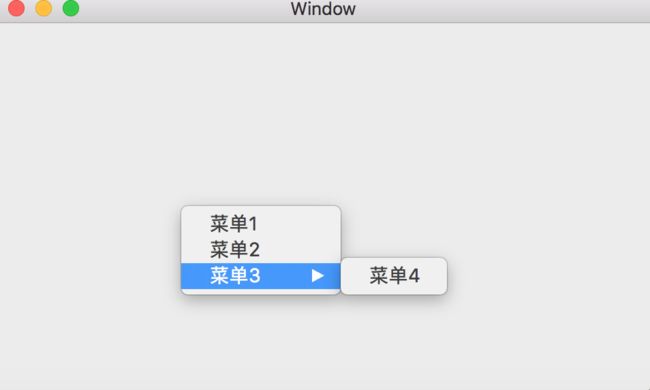文章来源汇总:
https://my.oschina.net/u/2340880/blog/1377546
https://blog.csdn.net/lovechris00
https://blog.csdn.net/lovechris00/article/details/78002161
https://blog.csdn.net/henanzhg/article/details/70598302
一、引言
NSMenu在Mac桌面软件开发中往往有3个方面的应用,作为程序的主菜单栏使用,作为视图邮件菜单使用和作为Dock菜单使用。
二、主应用菜单
使用Xcode新建OX S应用时,可以选择使用Storyboard。Storyboard里面会自动创建一个菜单栏,你可以自行在菜单中进行增删改操作,菜单中的Item触发方法也可以直接与AppDelegate进行关联,实现自定义的菜单逻辑,如图:
三:Dock菜单
当一款Mac桌面软件运行时,会在Dock栏上显示一个图标,当在此图标上点击右键时,会出现一个Dock菜单,自定义此Dock菜单也十分容易,直接在AppDelegate中重写如下方法即可:
-(NSMenu *)applicationDockMenu:(NSApplication *)sender{
NSMenu * menu = [[NSMenu alloc]initWithTitle:@"Menu"];
NSMenuItem * item1 = [[NSMenuItem alloc]initWithTitle:@"菜单1" action:@selector(click) keyEquivalent:@""];
item1.target = self;
NSMenuItem * item2 = [[NSMenuItem alloc]initWithTitle:@"菜单2" action:@selector(click) keyEquivalent:@""];
item2.target = self;
NSMenuItem * item3 = [[NSMenuItem alloc]initWithTitle:@"菜单3" action:@selector(click) keyEquivalent:@""];
NSMenu * subMenu = [[NSMenu alloc]initWithTitle:@"subMenu"];
NSMenuItem * item4 = [[NSMenuItem alloc]initWithTitle:@"菜单4" action:@selector(click) keyEquivalent:@""];
item4.target = self;
[subMenu addItem:item4];
[menu addItem:item1];
[menu addItem:item2];
[menu addItem:item3];
[menu setSubmenu:subMenu forItem:item3];
return menu;
}
效果如下:
在系统代理方法中返回该目录
- (NSMenu *)applicationDockMenu:(NSApplication *)sender
{
return self.dockMenu;
}
四、视图右键弹出菜单
视图右键弹出菜单是基于NSView视图的,例如:
- (void)viewDidLoad {
[super viewDidLoad];
NSMenu * menu = [[NSMenu alloc]initWithTitle:@"Menu"];
NSMenuItem * item1 = [[NSMenuItem alloc]initWithTitle:@"菜单1" action:@selector(click) keyEquivalent:@""];
item1.target = self;
NSMenuItem * item2 = [[NSMenuItem alloc]initWithTitle:@"菜单2" action:@selector(click) keyEquivalent:@""];
item2.target = self;
NSMenuItem * item3 = [[NSMenuItem alloc]initWithTitle:@"菜单3" action:@selector(click) keyEquivalent:@""];
NSMenu * subMenu = [[NSMenu alloc]initWithTitle:@"subMenu"];
NSMenuItem * item4 = [[NSMenuItem alloc]initWithTitle:@"菜单4" action:@selector(click) keyEquivalent:@""];
item4.target = self;
[subMenu addItem:item4];
[menu addItem:item1];
[menu addItem:item2];
[menu addItem:item3];
[menu setSubmenu:subMenu forItem:item3];
[self.view setMenu:menu];
}
效果如下:
五、NSMenuItem详解
NSMenuItem是菜单中的每一个菜单选项对象,其中常用属性方法如下:
//设置是否启用用户快捷键
+ (void)setUsesUserKeyEquivalents:(BOOL)flag;
//设置用户快捷键启用状态
+ (BOOL)usesUserKeyEquivalents;
//创建一个分割线
+ (NSMenuItem *)separatorItem;
//使用标题,快捷键和方法选择器来对Item进行初始化
- (instancetype)initWithTitle:(NSString *)string action:(nullable SEL)selector keyEquivalent:(NSString *)charCode;
//其所在的菜单对象
@property (nullable, assign) NSMenu *menu;
//其是否有子菜单
@property (readonly) BOOL hasSubmenu;
//子菜单对象
@property (nullable, strong) NSMenu *submenu;
//如果此Item是某个子菜单中的,此属性获取与子菜单关联的父item
@property (nullable, readonly, assign) NSMenuItem *parentItem;
//Item标题
@property (copy) NSString *title;
//富文本标题
@property (nullable, copy) NSAttributedString *attributedTitle;
//是否是分隔线Item
@property (getter=isSeparatorItem, readonly) BOOL separatorItem;
//绑定的快捷键
@property (copy) NSString *keyEquivalent;
//快捷键类型
/*
typedef NS_OPTIONS(NSUInteger, NSEventModifierFlags) {
NSEventModifierFlagCapsLock = 1 << 16, // Caps lock键
NSEventModifierFlagShift = 1 << 17, // shift键
NSEventModifierFlagControl = 1 << 18, // control键
NSEventModifierFlagOption = 1 << 19, // option键
NSEventModifierFlagCommand = 1 << 20, // command键
NSEventModifierFlagNumericPad = 1 << 21, // 小键盘任意键
NSEventModifierFlagHelp = 1 << 22, // 帮助键
NSEventModifierFlagFunction = 1 << 23, // 任意功能按钮
};
*/
@property NSEventModifierFlags keyEquivalentModifierMask;
//Item图标
@property (nullable, strong) NSImage *image;
//Item状态
@property NSInteger state;
//开启状态下的图标
@property (null_resettable, strong) NSImage *onStateImage;
//关闭状态下的图标
@property (nullable, strong) NSImage *offStateImage;
//混合状态下的图标
@property (null_resettable, strong) NSImage *mixedStateImage;
//是否有效
@property (getter=isEnabled) BOOL enabled;
//是否前置
@property (getter=isAlternate) BOOL alternate;
//Item缩进级别
@property NSInteger indentationLevel;
//设置交互响应者
@property (nullable, weak) id target;
//设置交互相应方法
@property (nullable) SEL action;
//设置tag值
@property NSInteger tag;
//是否高亮
@property (getter=isHighlighted, readonly) BOOL highlighted;
//设置是否隐藏
@property (getter=isHidden) BOOL hidden;
//设置提示文本
@property (nullable, copy) NSString *toolTip;
六、NSMenu详解
//初始化方法
- (instancetype)initWithTitle:(NSString *)title;
//标题
@property (copy) NSString *title;
//在所在的交互点弹出菜单
+ (void)popUpContextMenu:(NSMenu*)menu withEvent:(NSEvent*)event forView:(NSView*)view;
+ (void)popUpContextMenu:(NSMenu*)menu withEvent:(NSEvent*)event forView:(NSView*)view withFont:(nullable NSFont*)font;
- (BOOL)popUpMenuPositioningItem:(nullable NSMenuItem *)item atLocation:(NSPoint)location inView:(nullable NSView *)view NS_AVAILABLE_MAC(10_6);
//设置菜单栏是否可见
+ (void)setMenuBarVisible:(BOOL)visible;
+ (BOOL)menuBarVisible;
//父菜单
@property (nullable, assign) NSMenu *supermenu;
//插入Item
- (void)insertItem:(NSMenuItem *)newItem atIndex:(NSInteger)index;
- (NSMenuItem *)insertItemWithTitle:(NSString *)string action:(nullable SEL)selector keyEquivalent:(NSString *)charCode atIndex:(NSInteger)index;
//添加Item
- (void)addItem:(NSMenuItem *)newItem;
- (NSMenuItem *)addItemWithTitle:(NSString *)string action:(nullable SEL)selector keyEquivalent:(NSString *)charCode;
//删除某个位置的Item
- (void)removeItemAtIndex:(NSInteger)index;
//删除Item
- (void)removeItem:(NSMenuItem *)item;
//为某个Item设置子菜单
- (void)setSubmenu:(nullable NSMenu *)menu forItem:(NSMenuItem *)item;
//删除所有Item
- (void)removeAllItems;
//Item数组
@property (readonly, copy) NSArray *itemArray;
//获取Item个数
@property (readonly) NSInteger numberOfItems;
//获取某个位置的Item
- (nullable NSMenuItem *)itemAtIndex:(NSInteger)index;
//获取某个Item的位置
- (NSInteger)indexOfItem:(NSMenuItem *)item;
- (NSInteger)indexOfItemWithTitle:(NSString *)title;
- (NSInteger)indexOfItemWithTag:(NSInteger)tag;
- (NSInteger)indexOfItemWithSubmenu:(nullable NSMenu *)submenu;
- (NSInteger)indexOfItemWithTarget:(nullable id)target andAction:(nullable SEL)actionSelector;
//根据标题获取item
- (nullable NSMenuItem *)itemWithTitle:(NSString *)title;
//根据tag获取Item
- (nullable NSMenuItem *)itemWithTag:(NSInteger)tag;
//刷新菜单
- (void)update;
//获取菜单高度
@property (readonly) CGFloat menuBarHeight;
//取消菜单
- (void)cancelTracking;
- (void)cancelTrackingWithoutAnimation;
//获取高亮的Item
@property (nullable, readonly, strong) NSMenuItem *highlightedItem;
//最小宽度
@property CGFloat minimumWidth;
//尺寸
@property (readonly) NSSize size;
//字体
@property (null_resettable, strong) NSFont *font;
七、状态栏(NSStatusItem)添加菜单
Mac OS X有时会考虑添加NSStatusItem的情况,NSStatusItem并非Mac App必须要使用的,但使用NSStatusItem可以把一些简单的拓展功能放到这里,方便用户的使用。
很多App包括苹果公司本身都使用了NSStatusItem,如上图所示,下面我将分享一些NSStatusItem的使用经验。
使用NSStatusItem应该作为全局变量,而不是局部变量,如果作为局部变量,将没有效果。
.h文件中可以进行如下定义:
@interface AppDelegate : NSObject {
NSStatusItem *_statusItem;
}
.m文件进行如下实现:
_statusItem = [[NSStatusBar systemStatusBar] statusItemWithLength:NSVariableStatusItemLength];
[_statusItem setImage:[NSImage imageNamed:@"image.png"]];
[_statusItem setToolTip:@"StatusItem"];
[_statusItem setHighlightMode:YES];
使用位置
NSMenu *subMenu = [[NSMenu alloc] initWithTitle:@"Load_TEXT"];
[subMenu addItemWithTitle:@"Load1"action:@selector(load1) keyEquivalent:@"E"];
[subMenu addItemWithTitle:@"Load2"action:@selector(load2) keyEquivalent:@"R"];
statusItem.menu = subMenu;
八、给一个NSView添加右击菜单
这里的快捷键可能无法直接使用。邮件点击该 View,再使用快捷键有效。
一个目录可以添加给多个控件。
- (void)addViewMenu{
NSMenu *newMenu = [[NSMenu alloc] initWithTitle:@"View 的目录"];
NSMenuItem* newItem = [[NSMenuItem alloc] initWithTitle:@"View 的item" action:@selector(load1) keyEquivalent:@"E"];
[newItem setEnabled:YES];
[newItem setTarget:self];
[newMenu addItem:newItem];
[self.indicater0 setMenu:newMenu];
[self.indicater1 setMenu:newMenu];
}
总结:
1.一级目录 和 二级目录 都属于 NSMenu 类。
2.一级目录和二级目录的内容属于 NSMenuItem 类。
3.一个一级目录下,只能有一个二级目录,只能用 setSubmenu 设置一级下的二级目录;
4.二级目录下面可以有多个 item,可以用 addItemWithTitle 和 insertItemWithTitle 来添加。
5.keyEquivalent 是配置的快捷键,如果配置 E,则 command + shif + E 可以调用这个方法。 E 区分大小写,小写无效。
6.insertItem 的时候,需要注意 index 的位置。


